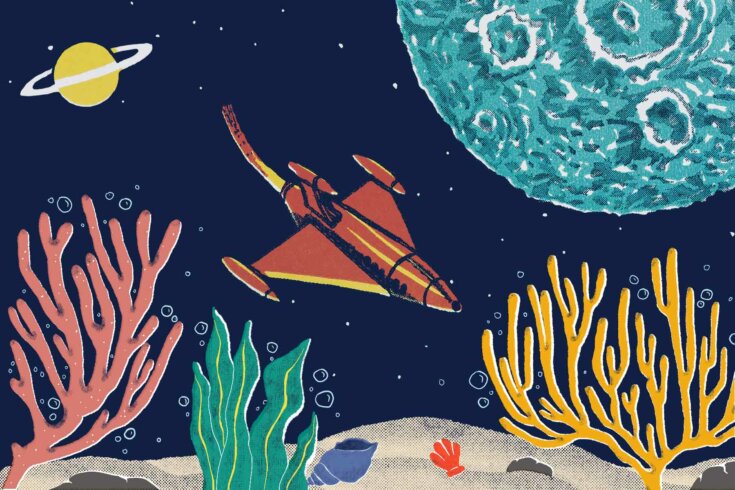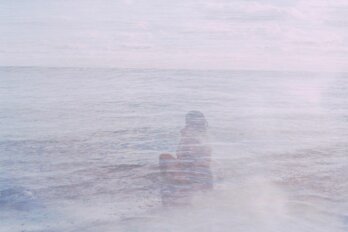The ocean and outer space are the two ideological end points in exploration, so naturally they share some of the same goals and technology. Deep-sea submersibles are built to withstand cold temperatures and high pressures as well as the corrosive effects of salt water. Once on their journeys, they perform routine tasks again and again, with little or no opportunity for repairs. Extraterrestrial rovers and spacecraft endure similarly extreme conditions and are dispatched on lifelong journeys to the ends of the universe, never to be seen by humans again. Astronauts and aquanauts train for their epic adventures in similar ways too. At NASA’s Neutral Buoyancy Laboratory in Houston, Texas, astronauts practise spacewalking in a mock-up of the International Space Station submerged at the bottom of a mammoth pool.
Only the elite can afford to pay for such activities, so the fields share another overlap in terms of who gets to do the exploring. Until recently, that meant the highest achievers in the military and scientific worlds. But after decades of neoliberal capitalism, hobbled government agencies, and the wealthiest people and corporations paying little to no tax, the richest people in the world can now launch private exploration companies that rival the US government’s. For now, the clients for deep-sea and space travel are other ultrarich patrons or government agencies, such as NASA contracting SpaceX to carry astronauts to the ISS. But the spacefaring entrepreneur Elon Musk—at one point the richest man in the world, whose car company, Tesla, paid zero federal income tax in 2021—dreams of a day when the masses can afford a trip to Mars. Of course, everyone would be better served by less flashy ambitions, such as a sustainable future here on planet Earth.
The two fields also share the hunt for extreme life that thrives in severe conditions found in the deep sea and on faraway planets. At NASA’s Jet Propulsion Laboratory in Pasadena, California, there’s a whole department devoted to exploring the overlaps between life at the bottom of the sea and on other “ocean worlds”: moons with water, such as Jupiter’s Europa and Saturn’s Enceladus. Marine scientists have learned to hitch their research to outer space to boost funding, and NASA has done the same, expanding and promoting its earth science research as the environmental movement has grown and pushed for public money to be put to use on this planet.
In 2021, I took a cruise on the exploration vehicle Nautilus up the California coast. NASA had funded the expedition thanks to a series of deep dives looking for extreme life forms. Immediately off the coast of Santa Barbara, the sea floor plunges 500 metres (1,640 feet) to a flat-basin bottom before it rises again to the Channel Islands. This bathtub shape creates a stagnant deep-sea environment that is perfect for sampling and studying life forms that can survive under high pressure and with little to no oxygen or sunlight. Those life forms might just look like the alien life we could find on distant planets. Or they might serve as good test subjects to send into space on a long galactic journey.
Watching the remotely operated vehicle Hercules scour the Santa Barbara Basin was the closest I came to exploring the sea floor myself. Patrick Lahey, the ever accommodating CEO of Triton Submarines, tried to take me on a test dive in the Bahamas that never materialized. Other options bubbled up and then faded away. I always knew my chances were slim. Far more worthy scientists had waited decades for a seat aboard a submersible. There were many paying customers ahead of me too. I asked the deep-sea explorer Victor Vescovo for a ride in his submersible, Limiting Factor, but he was charging customers $750,000 for a dive—way outside my price range but a steal compared to the $28 million Blue Origin charged its first client for a ride to the edge of space.
The ROV dives I watched off Santa Barbara gave me a glimpse into the commonalities between ocean and space exploration. Scientists have spent years studying and sampling the basin, making it among the most studied sea floors in the world, yet they’re still learning new and novel things about deep-sea life all the time. During the days I spent on board Nautilus, I watched scientists pull up deep-sea clams with a certain bacterium in their gills that allowed them to survive for up to ten months at a time without oxygen.
They were also on the hunt for foraminifera (known more colloquially as forams), a diverse group of microscopic shell-forming organisms that look quite pretty under an electron microscope, some shaped like pine cones, others like twisted tulip bulbs. Forams likely evolved more than 541 million years ago during the Precambrian period, so these single-celled organisms provide a glimpse into early life on Earth. They might also show what the future holds for the ocean. Forams flourish in so-called dead zones, which are spreading at sea due to climate change and pollution. Most people associate dead zones with river outlets, where runoff from fertilizer and human waste leads to phytoplankton blooms that strip oxygen from the water. However, dead zones also occur naturally at the bottom of stagnant ponds and bodies of water, such as the Santa Barbara Basin. The term “dead zone” is a bit of a misnomer, because life persists there, as the forams prove. As dead zones spread in the deoxygenating ocean, there might be many more forams at sea.
For the first dive of the cruise, the scientists were searching for bacterial mats where forams and other fascinating microbial communities gather. There were so many excited people on board who wanted to watch the first dive that half a dozen of us crowded into an overflow viewing room below the control van where the pilots directed ROV Hercules. The overflow room was actually Nautilus’s TV lounge, decorated in a mix of nautical and NASA. One side of the room was all portholes, wood panelling, and leather couches, the other a bank of computer screens filled with streaming data and live video feeds. As the dive unfolded, the researchers watched spellbound. It began, of course, at the surface of the sparkling blue sunlit waters. Within seconds of the ROV’s sinking, all light from above disappeared and the light from its headlamps grew brighter and almost eerie in the darkness, illuminating millions of particles swirling past. Those particles could mean life or death in the sea. They could be plankton; they could be microplastic; they could be marine snow—such a poetic term for floating feces or dead microscopic animals.
Watching the particles scroll past the black ocean background began to remind me of something. Vescovo had described seeing a similar view while descending into the deep ocean, but now I was watching it myself in real time. Then it came to me what it looked like: the night sky! We were sinking into the ocean, yet it looked as though we were roaming in outer space, each particle a star. “It’s like jumping into light speed,” one scientist behind me said, right on cue.
“Mat or no mat?” asked Nicole Raineault, the expedition leader. That was the question. The Santa Barbara Basin flushes itself sporadically, washing away the life that builds up on the bacterial mats. Without a mat, there would be no microscopic life for the scientists to sample and study. Raineault had taken a seat on the carpet, closest to the TV screen, and she worked her way around the room, taking guesses from all the researchers.
Watching the sea floor loom up underneath the ROV felt a bit like watching the sun rise. Staring at the dark night sky, you barely notice it lightening until, suddenly, brightness is shining all around you. The same thing happened in the deep sea: the black ocean lightened ever so gradually from black to blue, and then I realized that Hercules’s headlamp beams were bouncing off the bottom. Then everything came into focus very quickly; the sea floor sharpened, the texture resolved, the researchers leaned forward expectantly. The moment of truth had arrived.
One researcher, who had been too cautious to guess earlier, was perched right in front of the TV, his nose almost touching the screen. Hercules paused a moment, hovering sixty-five feet above the murky bottom. The researcher waved his hand impatiently—“C’mon, already! Get going!”—and then Hercules started to sink again. A flat, smooth, greyish bottom pulled into view, speckled with bright white patches. “Oh, yeah!” the researcher said excitedly, pulling back from the screen and grabbing his phone. “Those are mats.” The room broke into cheers and claps. It was the sea floor and the extreme life we’d come all that way to see.
For decades, marine conservationists and scientists have racked their brains trying to figure out why the public prefers to explore outer space over the ocean despite the many similarities between the two. The reasons seem to be political, psychological, and “very human,” as John Steinbeck pointed out all those years ago. The Cold War certainly played a role in funding space travel. (Of course, a sizable amount of military funding spilled into deep-sea exploration, too, especially during the time of Marie Tharp and Bruce Heezen, who collaborated to produce the first scientific map of the Atlantic Ocean floor in the 1950s.) In war, the tactical advantages of patrolling the skies and seas are clear. The United States and the Soviet Union wanted to spy and surveil, to launch missiles and warheads, but they also had to inspire the public with something more than militaristic ambition. The moon shot was perfect. “The same technology that transports a man to the Moon can carry a nuclear warhead halfway around the Earth,” the astronomer Carl Sagan wrote in a famous 1989 essay supporting nuclear disarmament.
But NASA’s moon shot also tapped into a deeper reality of why people prefer the skies to the seas. Fear plays a role in what the public chooses to support, as wolf conservationists know all too well. In nearly every seafaring culture, humanity’s fear of the deep takes the form of a sea monster, whether it’s the giant Kraken in Norse mythology or the Yacumama serpent slithering through the Peruvian Amazon. No matter how many statistics you cite on the improbability of a shark attack, sharks still play the role of bloodthirsty hunters of humans in the popular imagination today. A sizable part of society will always avoid deep water out of an instinctual fear—but a fear of what exactly?
Vescovo might have glimpsed the answer during his expedition to the deepest points on the planet. Not a single particle of light penetrates the ocean bottom, and Vescovo spoke of seeing the absolute blackest black he had ever seen outside his view port. “It was wild,” he wrote to me. “Absolutely zero depth perception. Total and utter void.” Sometimes he would turn off all the lights inside the submersible, cup his hands to the glass, and stare out into the abyss. The moment reminded him of the famous “staring into the abyss” quote from the German philosopher Friedrich Nietzsche: “He who fights with monsters should be careful lest he thereby become a monster. And if thou gaze long into an abyss, the abyss will also gaze into thee.” Perhaps here lies the real reason we fear exploring the deep sea: its darkness might destroy us.
Religious mythology can’t be discounted either. Heaven is up, just like the sky; hell is down, just like the ocean. Believers pray to a god above and look to the heavens for guidance and protection. They dread what lies beneath, where they’ll come to rest in an earthen grave or, worse, pay for their sins in hell. Regardless of whether you believe in a god or the afterlife, the religious orientation extends to the nonbeliever as well. Looking up at the stars and imagining a better place beyond the horizon is a uniquely human trait. It’s the same urge that compels us to travel to new lands and wonder about lives and perspectives beyond our own. But it also has the unfortunate downside of driving us to distraction, to hunger to be the “first,” and leading us astray from the difficult work of looking deeper inside ourselves and asking what a better world might look like right here, right now.
Holed up in the solitude of his cabin on Walden Pond, the American writer Henry David Thoreau ruminated on humanity’s endless wandering. He lived through what’s been called the second great age of discovery during the nineteenth century, when explorers and expeditions were setting out for the Arctic, the Amazon, Antarctica, and many other remote, uncharted landscapes. He was fascinated by those journeys and kept careful track of the discoveries, but he also seemed repelled by the insatiable urge to gobble up new terrain. “It is easier to sail many thousand miles through cold and storm and cannibals, in a government ship, with a hundred men and boys to assist one, than it is to explore the private sea, the Atlantic and Pacific Ocean of one’s being alone,” he wrote. Inner soul searching must accompany outward exploration or else we fall into a trap of ticking off new frontiers like an endless shopping list. Thoreau’s words also anticipate a time when we will have moved past exploring the ocean—one of the most cutting-edge pursuits of his day—and on to some new, more exciting frontier.
This is the situation we find ourselves in today. Around a quarter of the ocean floor has been mapped, less than 1 percent of the deep sea has been explored, but billions of dollars are being poured into space exploration and, even more recently, space militarization. The ocean—its inhabitants, geography, and meaning—are barely fathomed, yet the sea stirs up only a fraction of the excitement the other frontier does. The stiff headwinds of money and geopolitics have played some part, but so, too, have humanity’s psychological blind spots: by the early twenty-first century, no human had ever plumbed the deepest points of all five oceans.
Excerpt was originally published in The Deepest Map: The High Stakes Race to Chart the World’s Oceans copyright © 2023 by Laura Trethewey. Reprinted by permission of Goose Lane Editions.






